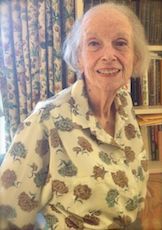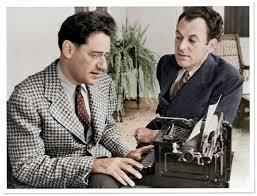As a kid, I used to bring home the plays of Kaufman and Hart from the local library and read them aloud with my little sister and my little brother, Elisa and Mark, on long Saturday afternoons. I don't recall how I discovered George S. Kaufman exactly but he somehow found me; he really made me laugh. His legend also appealed to me fiercely -- the stinging Kaufman wit behind the laconic Kaufman exterior: George S. Kaufman, in a telegram sent backstage to an over-emoting actor: "I am watching your performance from the rear of the house. Wish you were here." George S. Kaufman exiting the apartment of the erratically brilliant producer and director Jed Harris after a conference that Harris chose to conduct stark naked: "And Jed, you're fly is open."
In the winter of 1998, my editor at the New York Times Arts & Leisure section, the incomparable Andrea Stevens, announced to me that -- in the wake of a critically acclaimed revival of Kaufman and Ring Lardner's June Moon at the Drama Dept. (remember them?), and with a revival of Kaufman and Hart's maiden collaboration, Once in A Lifetime, pending at the Atlantic Theatre Company -- Andrea had a really good idea. I should take Kaufman's daughter, Anne Kaufman Schneider, and Hart's widow, Kitty Carlisle Hart, out to lunch for an interview, at the Algonquin Hotel, no less -- home of the legendary Round Table that George S. Kaufman helped make legendary, firing off epigrams over lunch throughout the Nineteen Twenties.
I accepted the assignment -- oh boy! To my added delight, Anne and I hit it off. (Kitty and I did, too, but with far more noblesse oblige on Kitty's part.) Anne and I have remained very chatty friends ever since.
Kaufman and Hart's You Can't Take It With You was a hit on Broadway after opening in December 1936 at the Booth Theatre and it's a hit again after opening two Sundays ago at the Longacre in a deliriously well-cast cast revival directed by Scott Ellis with just the right dash of daffy. The two productions, seventy-eight years apart, are spanned by at least one still thriving eyewitness, my friend Anne, who will soon turn 90. I called on Anne at her apartment on East 63rd Street the afternoon following opening night. I wanted to talk to her particularly about children and You Can't Take It With You. I had taken my own children -- Lea, age eleven, and Sara, age nine -- to a matinee performance the previous Saturday and, while they sat entranced and enraptured with laughter, I'd searched the audience in vain for any other young faces.
I thought this a tragic sign of something. Here was an absolutely irresistible play, sweet-tempered and hilarious, with a truly profound message for young and old alike. Yet, today's parents (I guess) perceive it as too musty for their young sophisticates. Better to haul the kids to jolting noisemakers like Matilda and Disney's many animated constructs for juveniles.
 "It is very good for children," Anne concurred, in her gravelly purr, as we settled into her sitting room overlooking Madison Avenue. "You care very quickly about each and every character. The authors have seen to that beautifully."
"It is very good for children," Anne concurred, in her gravelly purr, as we settled into her sitting room overlooking Madison Avenue. "You care very quickly about each and every character. The authors have seen to that beautifully."
You Can't Take It With You is the shaggy story of the Sycamores, a family of self-contented eccentrics who together inhabit a big old house on Claremont Avenue near Columbia University, filling it with their dilettante passions for ballet (Annaleigh Ashford in a dazzling performance of terpsichorean nuttiness, as the Sycamores' ever-dancing daughter, Essie); music (Will Brill, as Ed, Essie's perfectly matched mate in cuckoo creative aesthetics); playwriting (Kristine Nielsen, the Sycamores' mom, who writes plays because a typewriter was once mistakenly delivered to the house); and basement fireworks manufacturing (a sweetly restrained Mark Linn-Baker as Papa Paul Sycamore, abetted by the perfectly loopy Patrick Kerr as his assistant -- the Sycamores' permanent boarder, Mr. DePinna). The clan (and the production) are led by Grandpa Vanderhof (a majestically wily and, let's face it, wildly unexpected, James Earl Jones), who loves nothing more than attending collegiate commencement exercises and not paying his taxes.
"Where did Daddy and Moss get the idea?" asked Anne rhetorically. "I have no idea. Watching it again -- and I've now seen it three times, this go 'round -- I find it an odd play for Daddy to have been involved in. Because underneath all the lunatic goings on, the play is very sentimental. It's all about love. And that was a subject that didn't enter into the conversation with Daddy. The Sycamores all respect each other, and what they do, because they love each other, and love what they're doing. It really is about family love and understanding; something that didn't seem to happen a lot in our house. Though, maybe it did. My father wasn't a hugger. But it never occurred to me that he didn't care about me, didn't love me."
It is no secret that Anne Kaufman was adopted. She has spoken of it frequently. "They picked me out as a bundle at the orphan home when I was 3 months old," she reminded me now. "I was cute as a button - that's what Daddy said. He said I smiled at him. Maybe he told me a joke. Anyway, they brought me home to 158 West 58th Street, where we lived for a very short time, with the nanny and I in a little apartment on the same floor alongside my parents. This was when Daddy was still working at the New York Times as drama editor in 1925. Then we moved to a house on East 63rd Street, just down the block here. That's where I did most of my growing up. I passed the building not long ago and saw a man come out and lock the door of my old house. And for just an instant I was tempted to ask him to let me in to look around. But I couldn't do it."
 Moss Hart was introduced to George S. Kaufman in 1929, when Hart was twenty-five, unknown and virtually penniless (as later commemorated in his timeless memoir of their meeting, Act One). Kaufman, age forty, was just about the most successful playwright and director on Broadway; certainly where comedy was concerned. One of his many significant tics (including a phobia about physical contact that bred a compulsion for hand-washing) was a need to always write with a collaborator. Together, he and Hart rewrote the very promising play that the young hopeful had brought with him, Once in a Lifetime. The result was a huge Broadway hit that launched a ten-year reign for the team Kaufman and Hart.
Moss Hart was introduced to George S. Kaufman in 1929, when Hart was twenty-five, unknown and virtually penniless (as later commemorated in his timeless memoir of their meeting, Act One). Kaufman, age forty, was just about the most successful playwright and director on Broadway; certainly where comedy was concerned. One of his many significant tics (including a phobia about physical contact that bred a compulsion for hand-washing) was a need to always write with a collaborator. Together, he and Hart rewrote the very promising play that the young hopeful had brought with him, Once in a Lifetime. The result was a huge Broadway hit that launched a ten-year reign for the team Kaufman and Hart.
"I certainly do remember Moss around the house," laughed Anne. "Moss was always hungry because my father never seemed to eat anything. Poor Moss didn't know how to say, 'Excuse me, I'm hungry, could I talk to the cook for a minute?'
"They never said who did what," Anne added, "who wrote what. They really were like a married couple."
There is an offstage kitchen that looms large in the proceedings of You Can't Take It With You, dominated by the black family cook, Rheba, who rules her kitchen domain with the athletic assistance of her boyfriend, Donald. "During the original run, my school, the Dalton School, asked to do the play for two performances," remembered Anne. "Dalton was all-girls then, and I wound up playing Donald. I was eleven. My father directed me himself. Daddy wore nightshirts, so in my big scene, when Donald comes downstairs at night looking for candy, I wore one of my father's nightshirts."
I asked Anne how often her family sat down to dinner together, as the Sycamores did. Her eyes widened with amusement. "Maybe never. I ate with my nanny, who was German. She stayed nine years. I went to Germany with her on her holidays twice, near Nuremberg; that's where her parents lived. I don't know where my parents went."
Anne paused. "They had a baby before me who was born dead. A boy. And, from little things that were said very vaguely from time to time, I think they stopped having togetherness right about there. That's not unusual. They were both quite young. I think they cared for each other a lot, though. Daddy certainly cared what my mother thought when it came to his writing. 'Do you think this is good?' he would ask her. He depended on her. She was the first person to read everything. I know he and Moss had other titles for You Can't Take It With You: "Foxy Grandpa"; "Money in the Bank"; "The King is Naked"; "Grandpa's Other Snake." Mother hated them all. I don't think she suggested You Can't Take It With You as a title, but she did get them to change it.
"Beatrice was my mother's name. She was quite as literary, in her way, as Daddy; very social, very political, a great party giver, a great friend, and a very fine magazine writer and editor. She wasn't the kind of mother you read about in books, though.
"Mother fired my nanny and our German cook both, on the spot, when Hitler came to power. She didn't want any German servants in the house. Mother wasn't too smart about that, at least where her little daughter was concerned. I remember she took me to the movies that day. And I thought that was very strange. When I got home, the German nanny was gone. I ran up and down the house, calling her. I couldn't find her."
Anne smiled. "I ran into my nanny years later in Washington. I'd come down with my husband Irving to see Elaine Stritch go into Call Me Madam, after Ethel Merman. And I said to Irving one night in a restaurant, 'I think I see my German nanny over there.' Irving said, 'Don't be ridiculous. When did she leave?' 'When Hitler came in,' I said.
"Her name was Friedel. I went over and said, 'Excuse me, are you Friedel Schulein?' She looked up, kind of irritated, and said sharply, 'Yes.' And I said, 'Well, I'm Anne.' And I thought the two of us were going to burst into tears. We hugged."
To read more about George S. Kaufman, go to: www.georgeskaufman.com.

